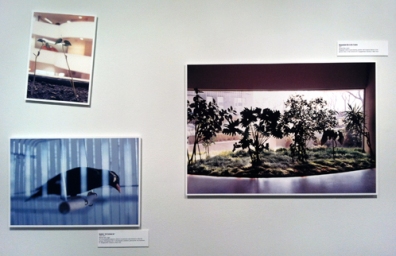They’re almost like pets.
 I’m referring to the floating and waving objects in the Hans Haacke show at MIT’s List Center which have a greater level of autonomy than I would have expected.
I’m referring to the floating and waving objects in the Hans Haacke show at MIT’s List Center which have a greater level of autonomy than I would have expected.
But then these are objects from 1967 (or recreations in some cases). Things just *were* freer back then.
A series of prints in a separate room document other works created by Haacke while he was at MIT. Included are images of more floating things: a whole string of balloons, for instance, like a parade of white geese or rotund pre-schoolers out for a ropey walk (the one where the tinies walk in a line clutching a rope that keeps them linked together).
*
At times it feels as if there’s a whole sub-genre of balloon work: wistful poignant photographs of balloons, balloon installations, sound artists who work with balloons, etc. Martin Creed’s Work no. 200: Half the air in an open space, 1998, for example. The Creed work uses balloons (half a room’s worth) and photographs quite well. I’ve never seen it in person.
Haacke used the balloons to explore and elaborate upon the concept of systems. Hence the autonomy which seems less a force in other artist’s balloon work. Other artist’s pieces seems more about aesthetics, or something vaguely conceptual (or even possibly jokey). On one of my visits to the List the floating corset piece (Flight, from 1965-6, recreated in 2011) dropped; something that occurs randomly and occasionally according to the gallery attendant. In some work this might seem a technical failure, something to ignore or pretend not to have seen. In the context of Haacke’s work its a rare exception, like witnessing a shooting star; something that strays from the memetic formula but is still part of the existing genotype. In science even failure can be a point of fascination.
*
 For some reason I equate balloons with birds.
For some reason I equate balloons with birds.
The Haacke show also contains images of birds, so maybe he was thinking the same.
If the art is birds, are the viewers cats? worms? This line of reasoning has the feeling of a Russian fiction: The Master and Margarita, perhaps.
In the small gallery at the List the prints are oddly hung; some “normally” but others seriously askew, leaving me to wonder if this manner of display is intentional or a mistake. If birds were the viewers and not the art they would have no issues with crooked art, mid-air re-calibration being rather a feature of their species.
*
Ten days later the prints (which are mounted on foam-core) are still crooked, though I can’t remember if its the same or different ones. I start wondering idly if Hans Haacke is a bird, and by extension whether I would be less annoyed by the orientation of the prints had a bird been responsible. Knowing this disarray to be some sort of avian conceptual gesture would certainly make things more interesting and the artist’s talk would be delightful . . . According to the front desk staff the prints are crooked by design (I don’t ask them about the Hans Haacke=bird stuff). Ultimately I think its a nice show and I like the floating ballon and corset pieces (the real ones, not the documentation). I wouldn’t call it great. It feels a bit sparse for all that space and I’m really not sure about all those crooked prints. A dedicated iPad would do just as well for the documentation. This is MIT, afterall. Maybe if they were framed?
*****
The Otto Piene light installation in the other half of the gallery is utterly transfixing. I have no desire to write about it as it strikes me that words would diminish its oneiric efficacy. Go see it. And look up MITHenge. I can’t help imagining a connection. Lights at the Palace of Technology.